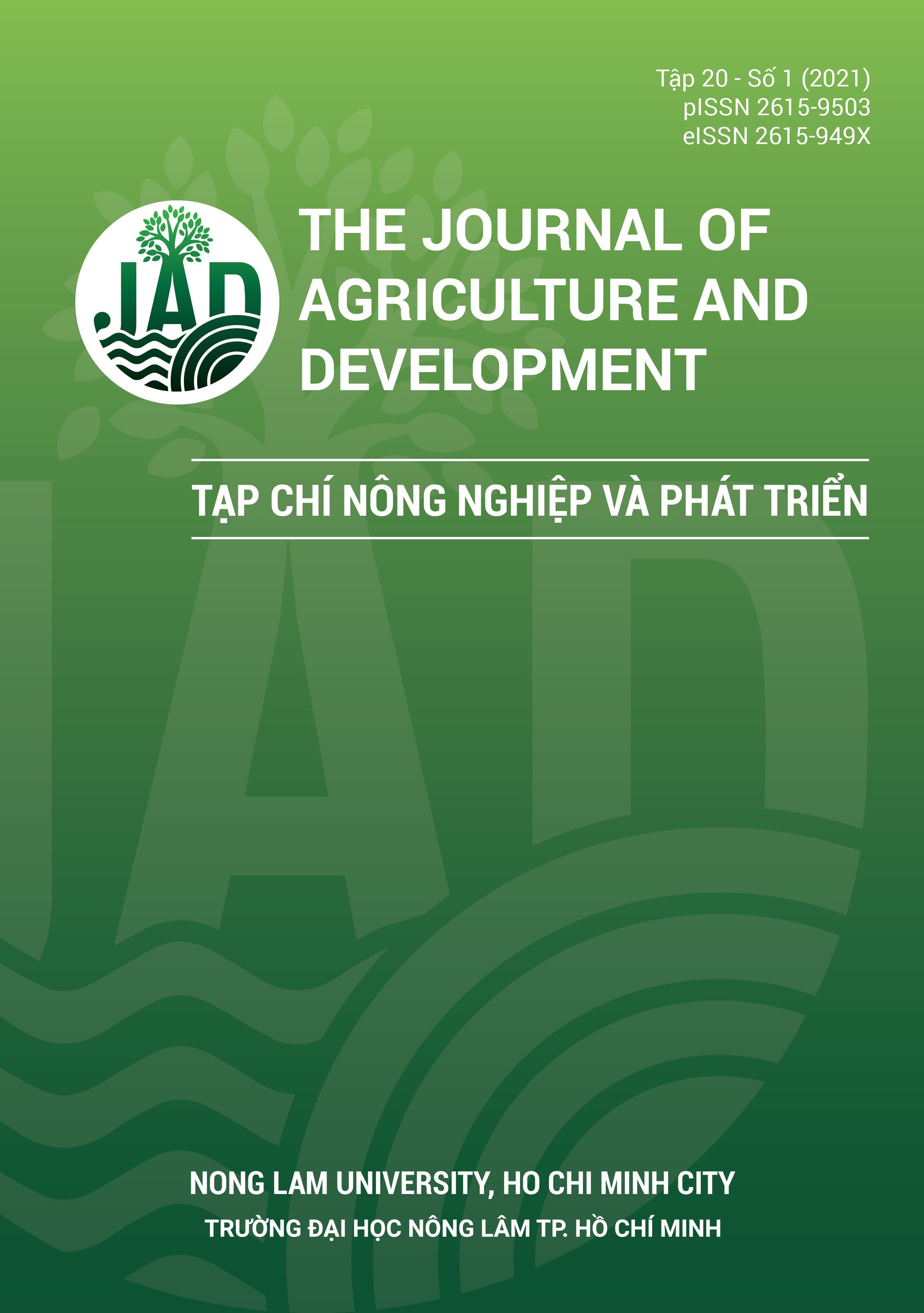Ước tính các thông số di truyền một số tính trạng quan trọng trên quần thể chọn giống rô phi đỏ thế hệ thứ 5 tại Việt Nam
Main Article Content
Tóm tắt
Nghiên cứu thực hiện ước tính các thông số di truyền bao gồm hệ số di truyền, tương quan di truyền và tương tác giữa kiểu gen và môi trường (GxE) các tính trạng tăng trưởng, tỷ lệ sống và màu sắc rô phi đỏ chọn giống thế hệ thứ năm sau khi nuôi ở ao nước ngọt và lợ mặn. Tổng cộng có 116 gia đình full- và half-sib được tạo ra, 4.432 và 3.811 cá giống được đánh dấu từng cá thể và thả nuôi đánh giá các tính trạng tương ứng trong ao nước ngọt và ao lợ mặn. Các thông số di truyền được ước tính bằng phần mềm ASReml 4.1.Hệ số di truyền đạt mức cao cho tính trạng khối lượng (0,42), tỷ lệ sống (0,58) và mức trung bình cho màu sắc (0,23) nuôi ở môi trường nước ngọt, trong khi đó 3 tính trạng tương ứng ở môi trường nước lợ là 0,26; 0,26 và 0,29.Kết quả này cùng với các giá trị công bố ở các thế hệ trước cho thấy tiềm năng chọn lọc mang lại hiệu quả từ trung bình đến cao cho từng tính trạng. Tương quan di truyền khác zero (0) không có ý nghĩa thống kê(P > 0,05) được tìm thấy giữa ba tính trạng (từ -0,25 đến 0,37) cho thấy chọn lọc nâng cao một trong ba tính trạng sẽ không ảnh hưởng đến hiệu quả của tính trạng còn lại. Tương tác GxE cho các tính trạng tăng trưởng và màu sắc giữa hai môi trường nước ngọt và lợ mặn là không đáng kể (với hệ số tương quan 0,63 - 0,80), nhưng tương tác đáng kể cho tính trạng tỷ lệ sống giữa hai môi trường nuôi được tìm thấy (rg=-0,17 ± 0,40).
Article Details
Tài liệu tham khảo
Bentsen, H. B., Gjerde, B., Nguyen, N. H., Rye, M., Pon- zoni, R. W., Palada de Vera, M. S., Bolivar, H. L., Velasco, R. R., Danting, J. C., Dionisio, E. E., Longa- long, F. M., Reyes, R. A., Abella, T. A., Tayamen, M. M., & Eknath, A. E. (2012).Genetic improvement of farmed tilapias: Genetic parameters for body weight at harvest in Nile tilapia (Oreochromis niloticus) during five generations of testing in multiple environments. Aquaculture 338-341, 56-65. https://doi.org/10.1016/j.aquaculture.2012.01.027
Gilmour, A. R., Gogel, B. J., Cullis, B. R., Welham, S. J., & Thompson, R. (2015). ASReml user guide release 4.1 structural specifcation. Hemel Hempstead, England: VSN International.
Gjerde, B. (2005). Design of breeding programs. In Gjedrem, T. (Ed.). Selection and breeding programs in aquaculture (73-195). Heidelberg, Netherlands: Springer. https://doi.org/10.1007/1-4020-3342-7_12
Nguyen, H. N., Hamzah, A., & Thoa, N. P. (2017). Effects of genotype by environment interaction on genetic gain and genetic parameter estimates in red tilapia (Oreochromis spp.). Frontiers in Genetics 8, 82. https://doi.org/10.3389/fgene.2017.00082
Nguyen, H. V. (2021). “Mighty eagerness” in the version for the lunar new year. Vietnam Fisheries Magazine 3&4, 86-87.
Nguyen, T. V., Nguyen, V. S., Tran, H. P., Nguyen, T. V.,& Nguyen, N. H. (2019). Genetic evaluation of a 15 - year selection program for high growth in striped cat- fish Pangasianodon hypophthalmus. Aquaculture 509, 221-226. https://doi.org/10.1016/j.aquaculture.2019.05.034
Nguyen, V. S., Nguyen, T. L., Nguyen, V. H., Tran, V. N., Nguyen, T. V., & Nguyen, H. N. (2020). Genotype by environment interaction for survival and harvest body weight between recirculating tank system and pond culture in Penaeus monodon. Aquaculture 525, 735278. https://doi.org/10.1016/j.aquaculture.2020.735278
Robertson, A. (1959). The sampling variance of the genetic correlation coefficient. Biometrics 15(3), 469-485. https://doi.org/10.2307/2527750
Sae-Lim, P., Gjerde, B., Nielsen, H. M., Mulder, H., & Kause, A. (2016). A review of genotype-by-environment interaction and micro-environmental sensitivity in aquaculture species. Aquaculrue 8(4), 369-393. https://doi.org/10.1111/raq.12098
Thodesen, J., Rye, M., Wang, Y. X., Li, S. J., Bentsen,H. B., Yazdi, M. H., & Gjedrem, T. (2013). Genetic improvement of tilapias in China: genetic parameters and selection responses in growth, survival and exter- nal color traits of red tilapia (Oreochromis spp.) after four generations of multi-trait selection. Aquaculture 416-417, 354-366. https://doi.org/10.1016/j.aquaculture.2013.09.047
Tran, D. T., & Dang, H. L. (2005). Genetic basis and selective breeding in fish. Nha Trang, Vietnam: Nha Trang Fisheries University.
Trinh, Q. T., Nguyen, V.S., Tran, H. P., Nguyen, C. M.,Pham, D. K., Lao, T. T., & Le, T. D. (2013). Genetic papameters of growth rate on red tilapia (Oreochoromis spp.). Mekong Journal of Fisheries 2, 24-29.
Trinh, Q. T., Phạm, D. K., Le, T. D., Nguyen, T. T., Nguyen, T. V., & Nguyen, T. D. (2017). Red tilapia seed improvement through 3 generations of selection. Mekong Journal of Fisheries 10, 66-75.
Trinh, Q. T., Phạm, D. K., Le, T. D., Nguyen, T.T., Nguyen, T. V., Nguyen, T. D., & Tran, H. P. (2016). Final report of project 'application of molecular and quantitative genetics for selective breeding of red tilapia (Oreochromis spp.) for improving growth rate'. Ho Chi Minh City, Vietnam: Research Institute of Aquaculture 2.
WFC (World Fish Center). (2004). GIFT technol- ogy manual: An aid to tilapia selective breeding. Penang, Malaysia. Retrieved January 21, 2021, from https://www.worldfishcenter.org/content/gift-technology-manual-aid-tilapia-selective-breeding.








